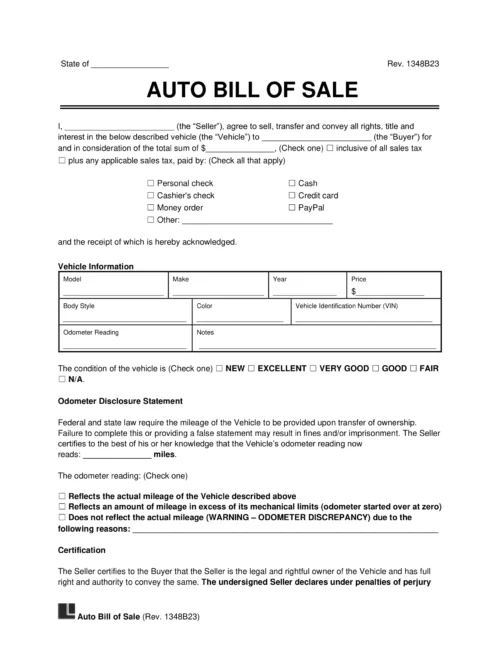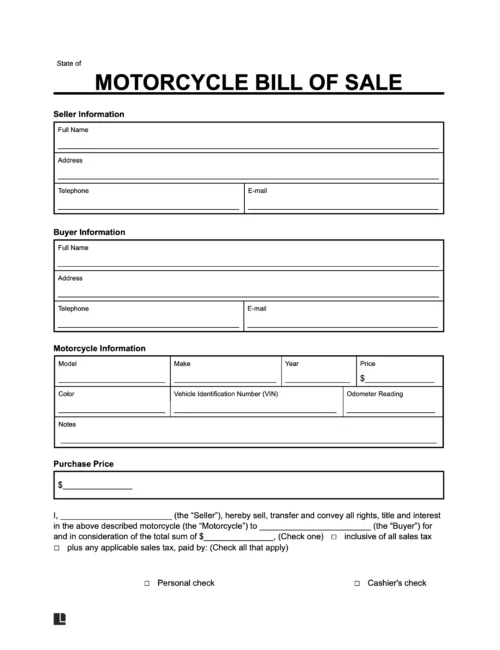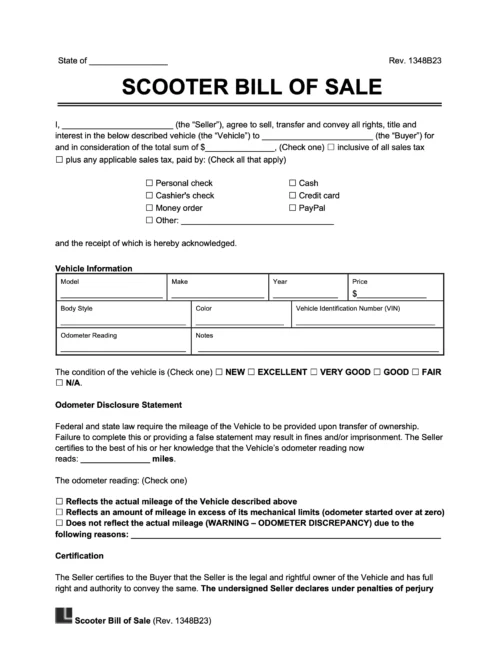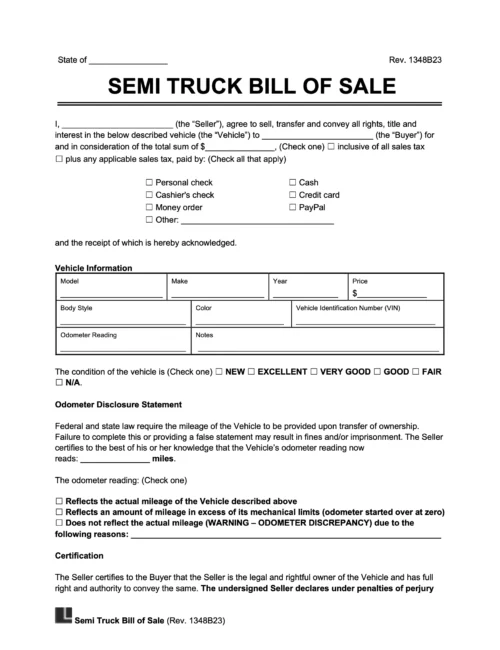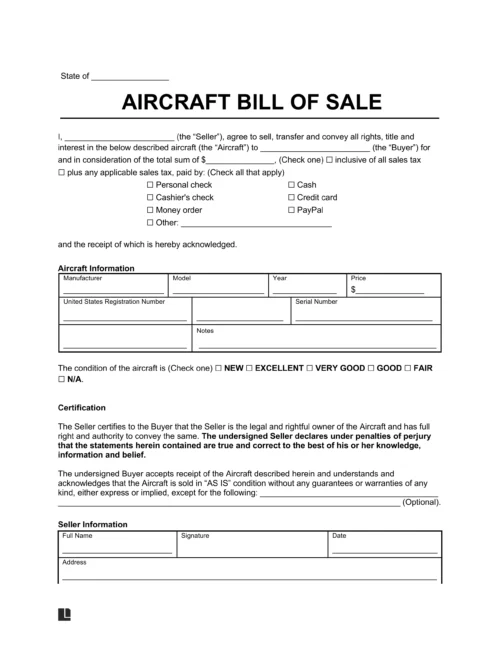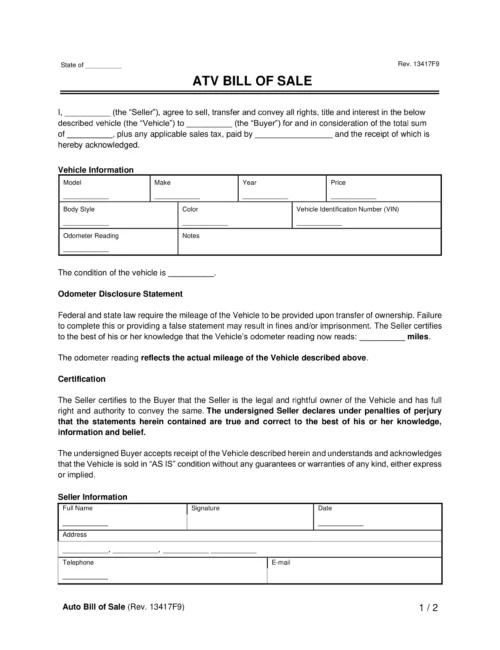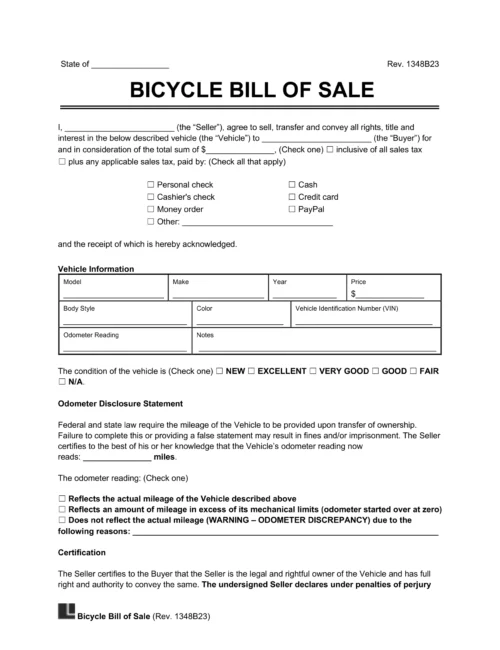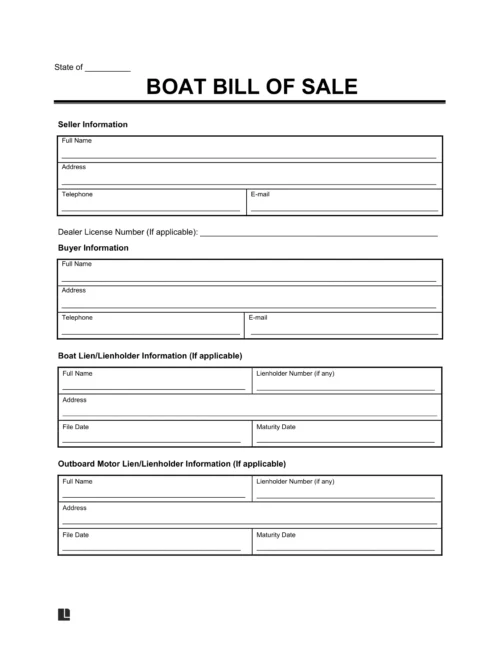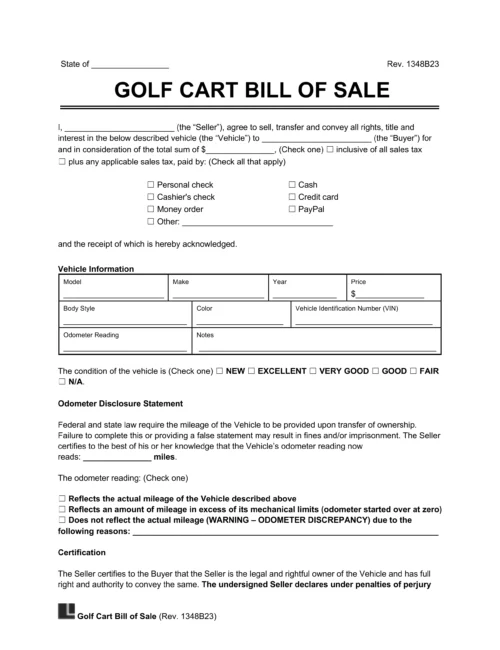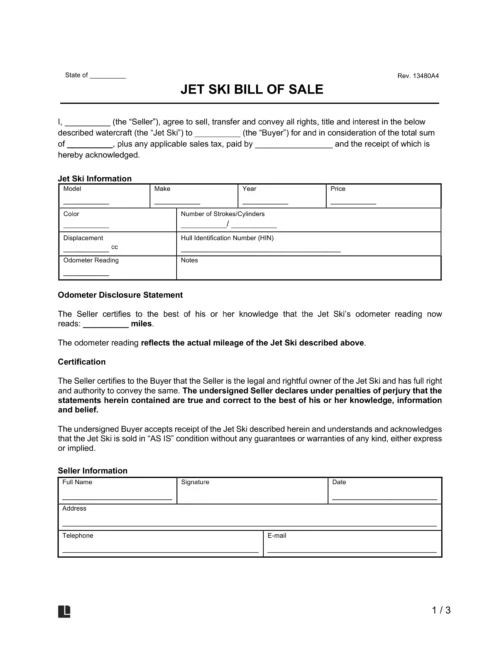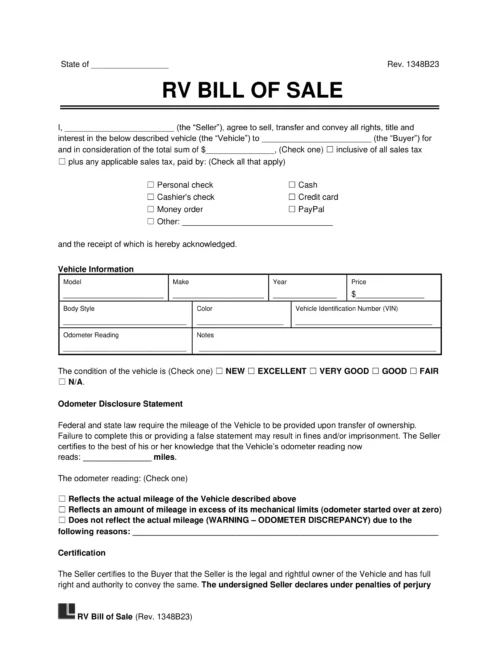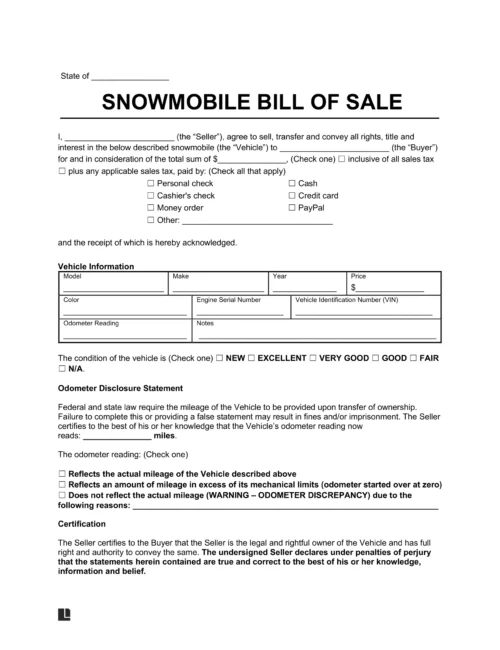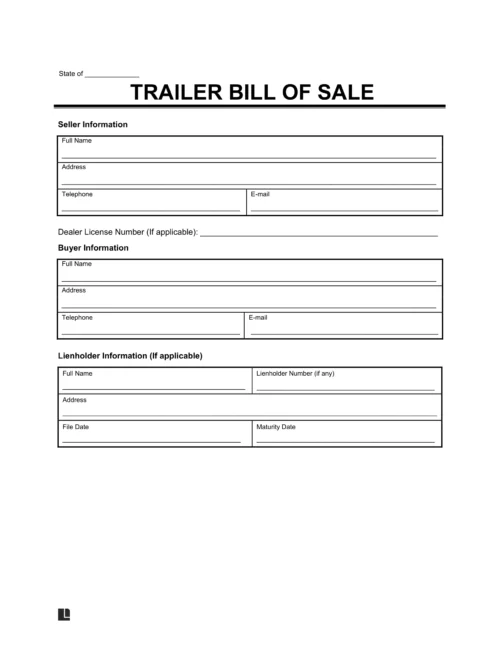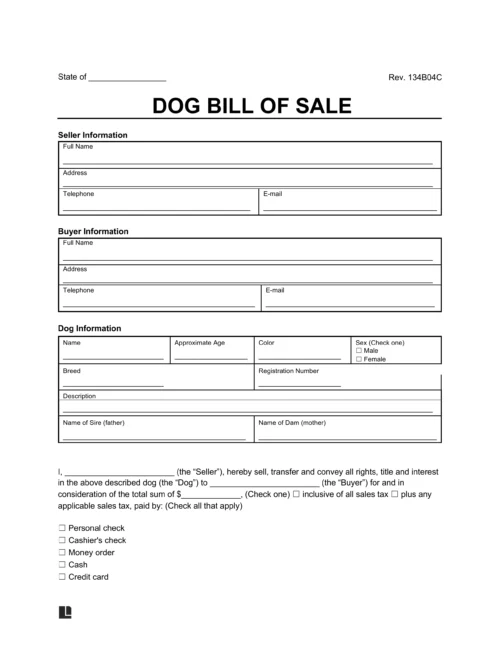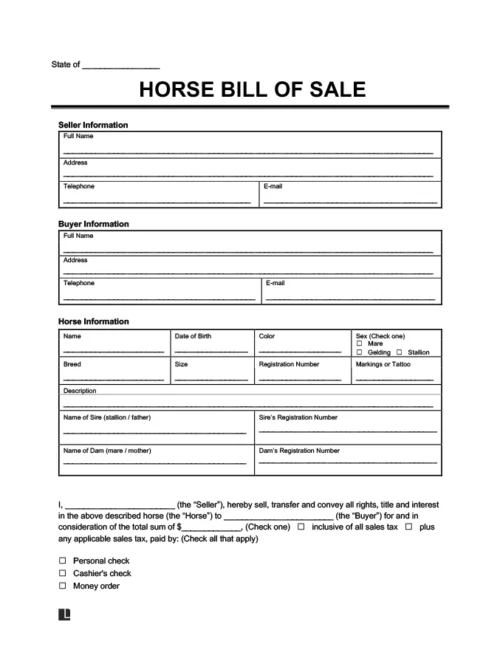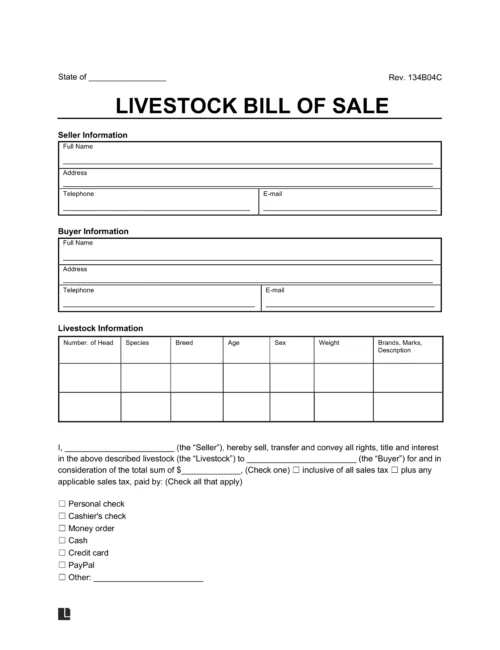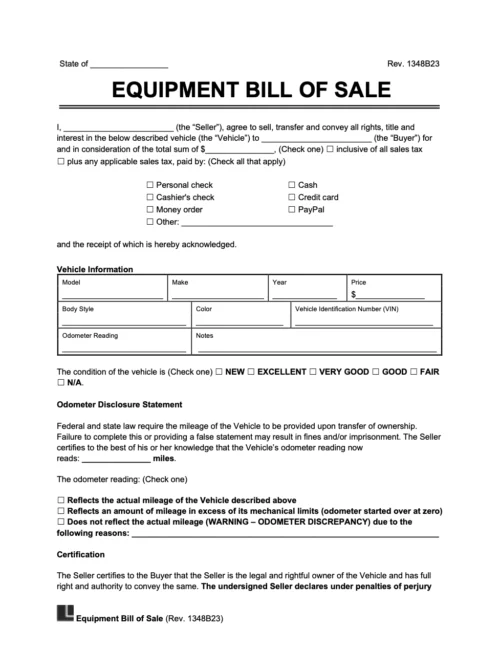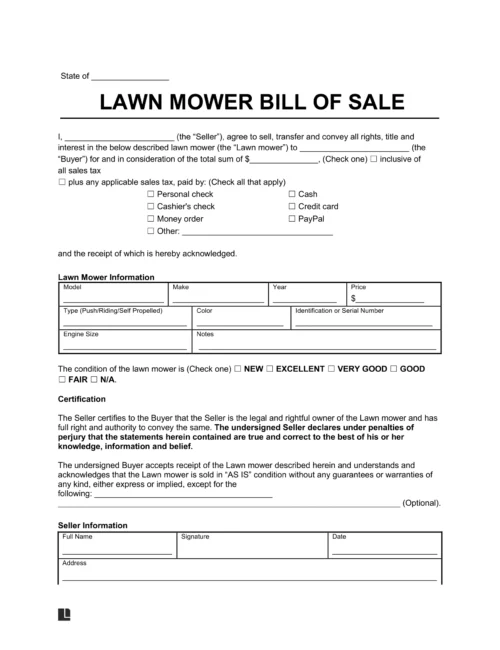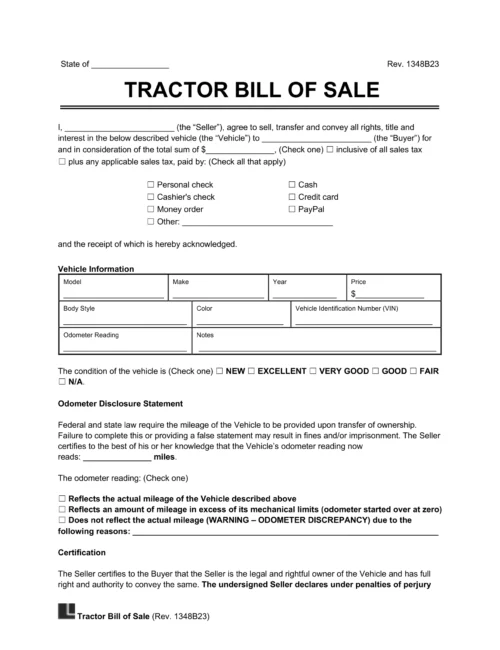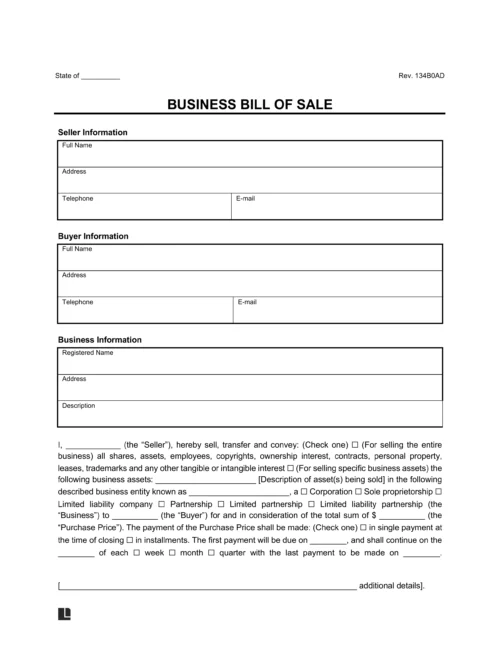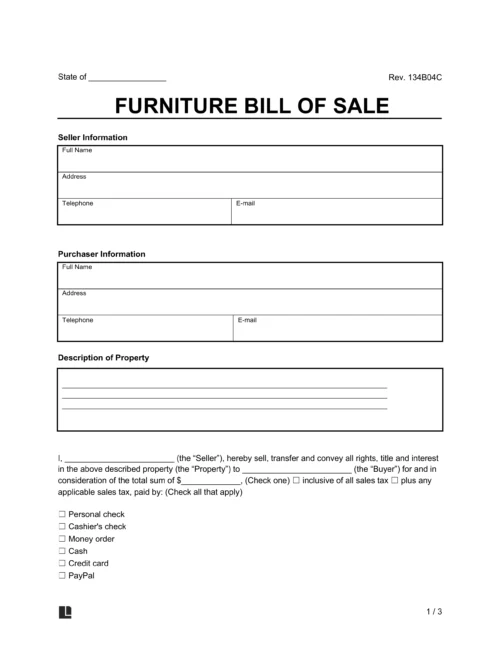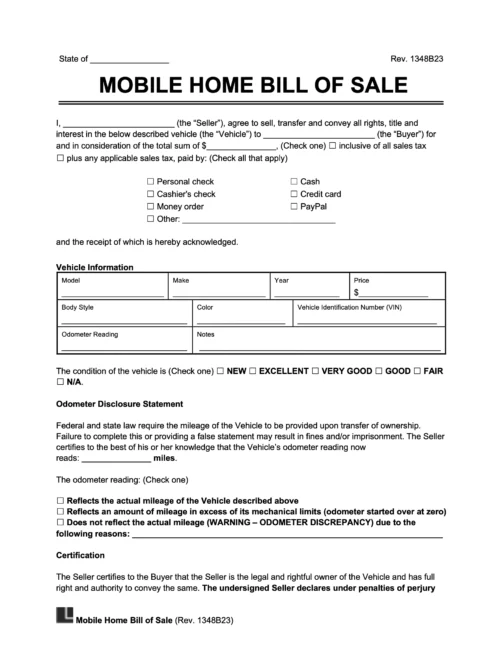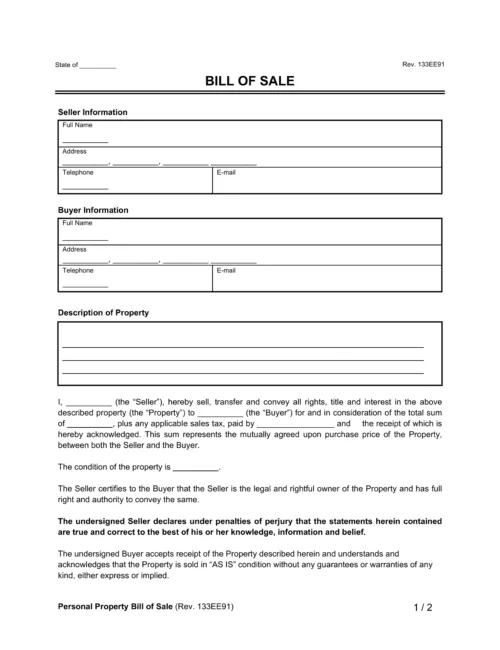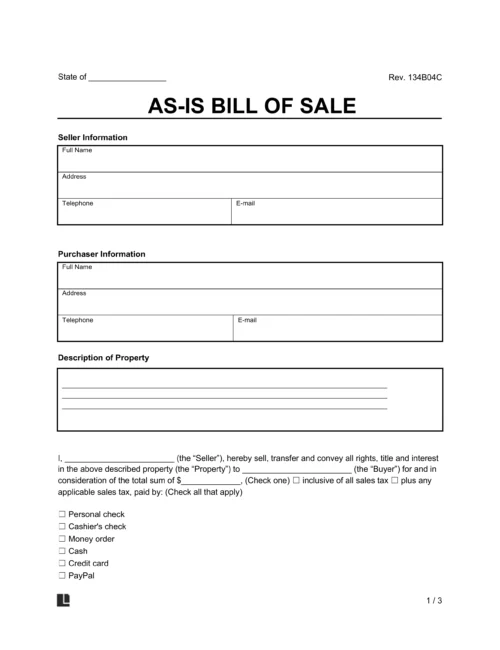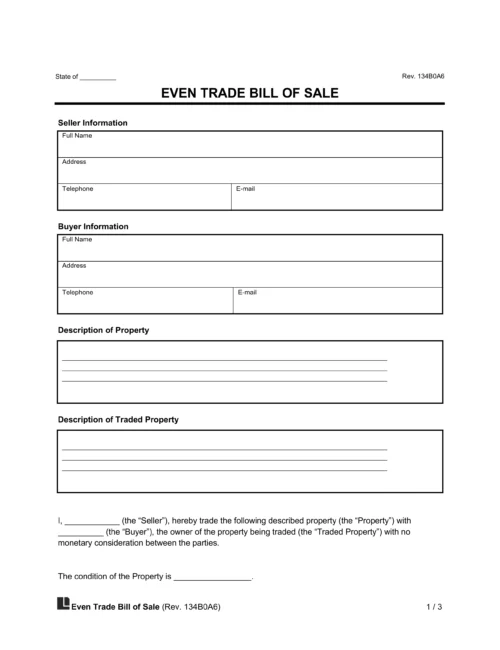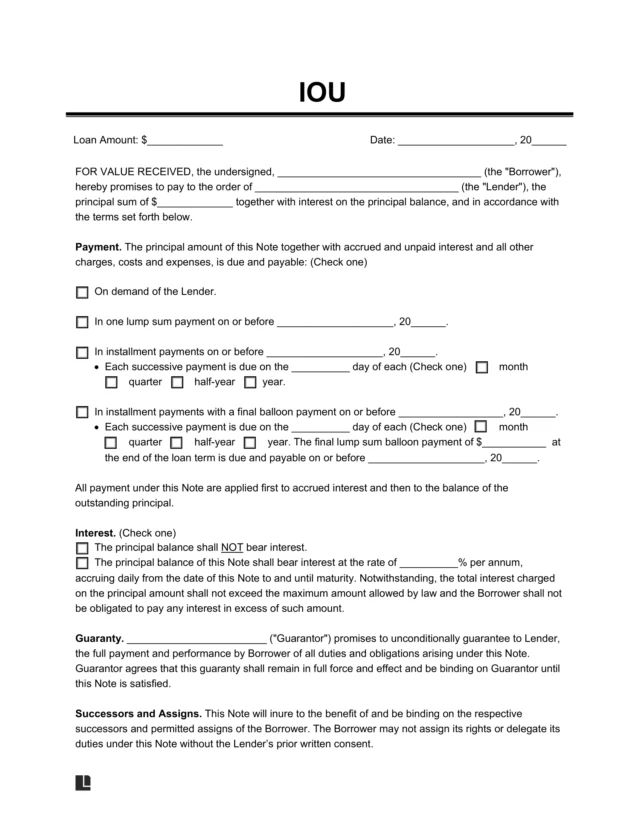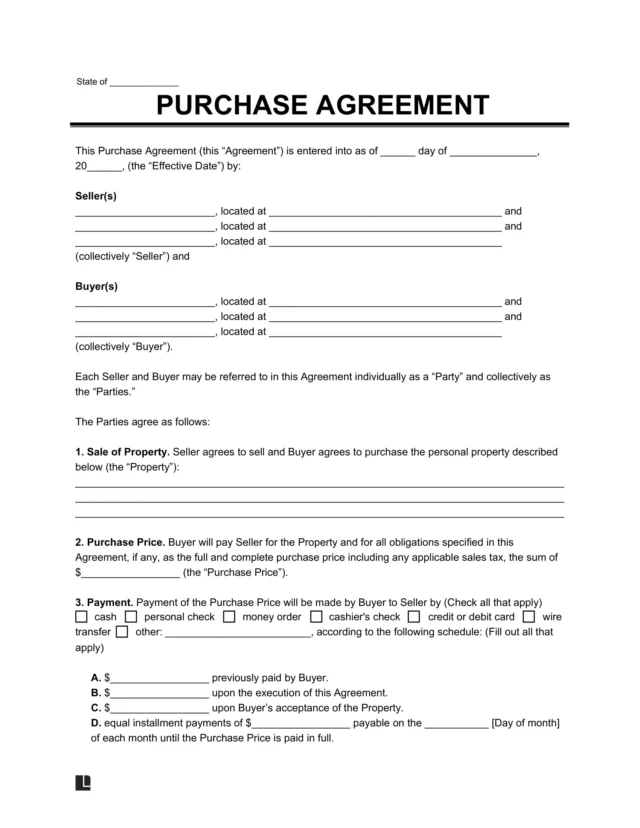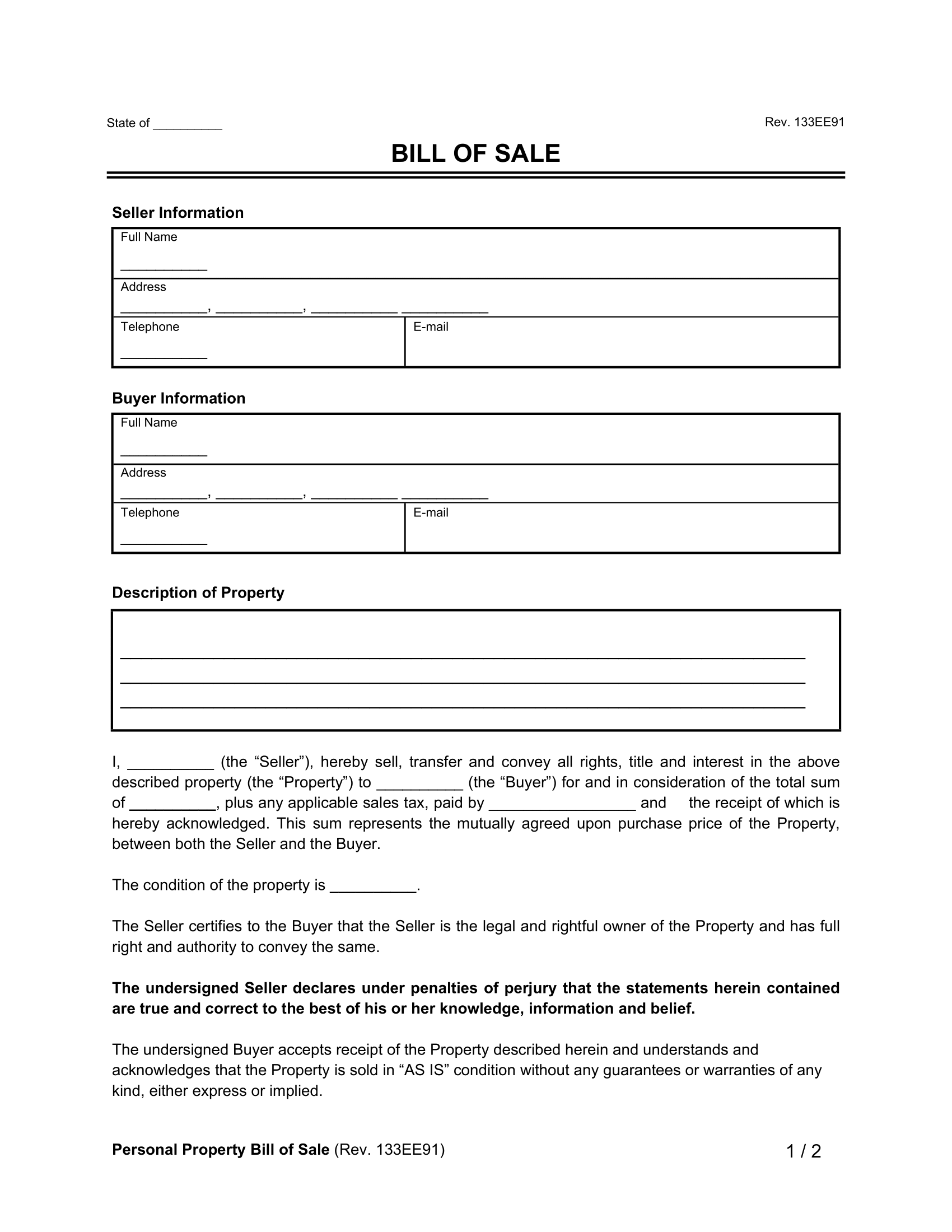Bill of Sale Templates – By Type
Buyers and sellers often use a bill of sale to show that a car or another motor vehicle sale has occurred. However, bills of sale can prove other item transactions as well. Explore our bill of sale templates by type to find the one that works best for your deal.
Vehicle Bills of Sale
Planning to sell or buy a car, motorcycle, or another vehicle? Use our customizable templates to document and secure your vehicle ownership transfer.
Allows you to sell or transfer ownership of a motor vehicle, including automobiles, trucks, and vans
Motor Vehicle Bill of Sale
Leisure & Specialty Vehicle Bills of Sale
For transactions beyond more standard commutes, our templates cover boats, RVs, ATVs, and more. They ensure your specialty vehicle deals are documented clearly and confidently.
Animal Bills of Sale
Securely document the transfer of pets or livestock with a clear, legally recognized animal bill of sale.
Equipment & Machinery Bills of Sale
Ensure a smooth, traceable transaction when buying or selling tools, heavy equipment, or machinery.
Personal Property & Business Asset Bills of Sale
Transfer ownership of everyday items and valuable assets with bills of sale for personal property and business needs.
General & Conditional Bill of Sale Forms
Whether gifting property, selling items “as-is,” or making an even trade, these bills of sale help protect both parties. Use our templates to handle various personal property transactions and keep your records precise.
Bill of Sale Templates – By State
Depending on your state, you may need a bill of sale to complete a transaction (especially vehicle sales). Even if it’s not mandatory for your deal, you can still benefit from having a state-specific form to clarify the nature of your transaction. Explore our state-specific templates below.
- Alabama
- Alaska
- Arizona
- Arkansas
- California
- Colorado
- Connecticut
- Delaware
- District of Columbia
- Florida
- Georgia
- Hawaii
- Idaho
- Illinois
- Indiana
- Iowa
- Kansas
- Kentucky
- Louisiana
- Maine
- Maryland
- Massachusetts
- Michigan
- Minnesota
- Mississippi
- Missouri
- Montana
- Nebraska
- Nevada
- New Hampshire
- New Jersey
- New Mexico
- New York
- North Carolina
- North Dakota
- Ohio
- Oklahoma
- Oregon
- Pennsylvania
- Rhode Island
- South Carolina
- South Dakota
- Tennessee
- Texas
- Utah
- Vermont
- Virginia
- Washington
- West Virginia
- Wisconsin
- Wyoming
What Is a Bill of Sale?
A bill of sale is a legal document showing that an item’s sale occurred. It proves that the item’s ownership went from the seller to the buyer.
With a bill of sale, you can prove that the buyer now owns the item, preventing disputes. It can also help you register an item (like a vehicle) and handle tax filing. Plus, some states require a bill of sale for certain transactions, so it’s a good way to make sure you’re following the rules.
A bill of sale should contain the following details to make it comprehensive:
- Item description
- Vehicle Identification Number (if it’s a vehicle sale)
- Sale price
- Sale terms
- Location and date of sale
- Parties’ signatures
- Warranty, conditions, and other terms
Is a Bill of Sale Legally Binding?
A bill of sale can be legally binding, but it depends on the transaction type and your jurisdiction. In general, a bill of sale is enforceable if the following statements are true:
- The buyer and seller sign it willingly.
- There is consideration (i.e., money for goods).
- The exchange of goods is lawful.
- Any additional terms or warranties are explicitly outlined.
- There is no misrepresentation of the for-sale items.
Is a Bill of Sale Enough for My Needs?
If you’re dealing with more complex transactions, a bill of sale may not be the only document you need. For example, a more detailed sales agreement can help you handle higher-value items. If you’re agreeing on a payment plan and need to structure the repayment, you can use our payment plan agreement.
You should also consider what the seller is providing to the buyer. Bills of sale are only for physical items, so you can use Legal Templates’s service agreement to detail the provision of services.
How to Write a Bill of Sale
Writing a bill of sale can be seamless if you have the right details. Follow these steps to create a solid document that offers protection to the involved parties.
Step 1 – List the Date & Party Details
Write the current date at the top of the document. This detail establishes when the sale took place, which creates a clear timeline for legal and tax reasons.
Also, include the full names and addresses of both parties. These details identify who is involved in the transaction and which parties are giving up and receiving ownership. If the buyer or seller is a business, include the business name and address as well.
Step 2 – Provide a Detailed Item Description
Include key details to identify the item being sold. If you’re selling a car, you can provide details such as the:
- Make
- Model
- Year
- Odometer reading
- VIN
- Color
- Condition
The information in the item description will differ depending on the item. For example, if you’re selling a camera, the details may include the make, model, serial number, accessories, software, and digital licenses.
Be Transparent When Describing the Item
Always be honest about the item’s condition so the buyer knows exactly what they’re getting. This transparency can prevent disputes and requests for a refund. It also helps you abide by laws like the Uniform Commercial Code, which indirectly promotes transparency by holding sellers accountable for the product description and quality.
Step 3 – State the Selling Price
Clearly list the agreed-upon selling price for the item, including any taxes or additional fees. Specify if you’re offering a discount or if the item includes additional services, like free shipping or delivery. The price you list in your bill of sale should be final, so be sure to negotiate before writing it.
Step 4 – Outline the Payment Terms
Specify the buyer’s payment method. Indicate which methods you accept; for higher-value items, you may consider more secure methods than cash, like a cashier’s check or bank transfer.
Clarify if the payment will occur in one amount or installment payments to ensure both parties are on the same page regarding how the transaction will occur. If the transaction is structured more as a loan between friends or family members, consider using a promissory note to formalize the payment terms.
Step 5 – Include Warranties
Add warranties if you want the purchase to have any promises or guarantees. These warranties give confidence to the buyer and ensure that the sale will only happen if these conditions are met. If these conditions are not met, the warranty allows the seller to repair, replace, or refund the item within a certain period (if specified).
Step 6 – Add Signatures
Both the buyer and seller need to sign the bill of sale form to make it official. If either party omits their signature, the bill of sale won’t be valid, and your transaction could be questioned later.
Once the bill of sale is complete, provide each party with a copy for their records. Store it in a safe place to refer to in case any issues arise. Use it to register your purchased item at the DMV or another government office if needed.
Does a Bill of Sale Need to Be Notarized?
Notarizing a bill of sale is not usually required. However, you can get notary acknowledgment to confirm that the signatures are genuine and that the parties are who they say they are. This can increase the document’s validity if disputes arise.
Sample Bill of Sale
Wondering what a bill of sale looks like? View a free sample below, then use our editable bill of sale form to create your own. Downloadable as a PDF or Word file.



